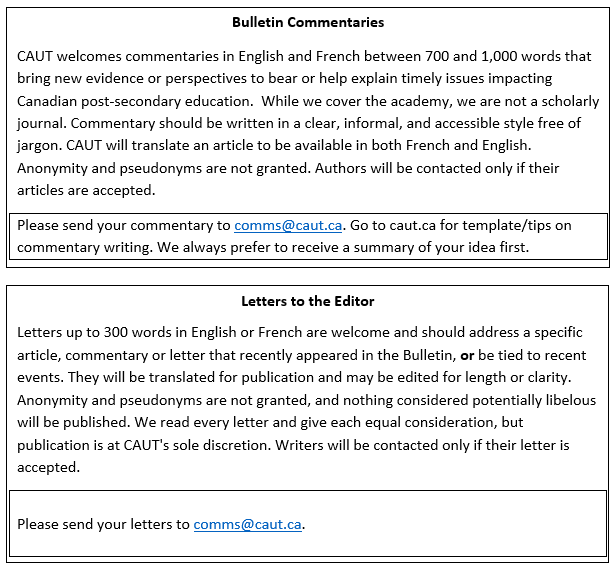CAUT Submission Guidelines
Guidelines for commentary submissions:
Do you work in a Canadian post-secondary education (PSE) setting as a teacher? a researcher? A unionist?
If you want to add your voice to the PSE conversation, consider contributing your experience and expertise with a commentary post.
Submissions may cover a wide range of topics but should resonate with academic staff at colleges and universities across the country.
You can send a short abstract outlining the issues you intend to address in your contribution or directly submit your full text, in compliance with the following drafting guidelines and using the attached template.
CAUT Bulletin commentary template
- Title (8-10 words max, reflects main point):
- Commentary (700-1000 words) // (See writing tips for specific guidance)
- Author’s name/Twitter handle
- Short biography (50-100 words):
- Attachments: high-resolution head-shot if available
Please send your commentary to comms@caut.ca.
Tips : How to write a good commentary
- Get to the point: Make sure your argument is clearly articulated so that any reader will have no difficulty understanding.
- Timeliness: make sure to immediately contextualize your commentary so the reader knows why they should continue to read. Use “hooks” like the publication of a new report, an anniversary or an event to assert the timeliness of the issue.
- Friendly and accessible tone: This isn’t a thesis. Try to be conversational, jargon and acronym-free, and make sure to provide context/explanation. While you should substantiate your assertions, do NOT over-cram with data and facts.
- First-person perspective: don’t hesitate to share personal stories, experiences and your impressions in order to grab readers’ interest. While you’re at it, pose questions, make assertions and even be a bit provocative: this is about stimulating thought and debate.
- Hyperlinks to further reading or detailed information are encouraged. Footnotes and digression are not.
- Our audience is largely Canadian, and it’s a big country: make sure to explain regional events, and any local cultural or historical conditions under discussion.
- Dissemination: provide your Twitter handle and any other @/# you’d like us to use after publication, so we can share and tag you widely. Make sure to share as well!
